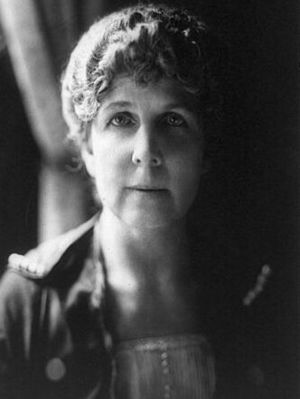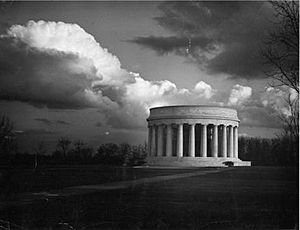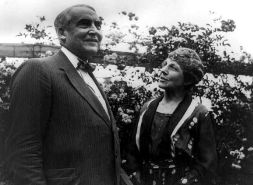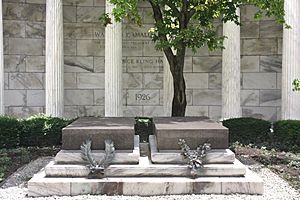Florence Harding facts for kids
Quick facts for kids
Florence Harding
|
|
|---|---|

Harding in 1920
|
|
| First Lady of the United States | |
| In role March 4, 1921 – August 2, 1923 |
|
| President | Warren G. Harding |
| Preceded by | Edith Wilson |
| Succeeded by | Grace Coolidge |
| Second Lady of Ohio | |
| In role January 11, 1904 – January 8, 1906 |
|
| Lieutenant Governor | Warren G. Harding |
| Preceded by | Esther Gordon |
| Succeeded by | Caroline Harris |
| Personal details | |
| Born |
Florence Mabel Kling
August 15, 1860 Marion, Ohio, U.S. |
| Died | November 21, 1924 (aged 64) Marion, Ohio, U.S. |
| Resting place | Harding Tomb |
| Spouses |
|
| Children | Marshall |
| Education | Cincinnati Conservatory of Music |
| Signature | |
Florence Mabel Harding (born Kling; August 15, 1860 – November 21, 1924) was the First Lady of the United States from 1921 to 1923. She was the wife of President Warren G. Harding.
Florence first married Henry De Wolfe and had a son named Marshall. After their divorce, she married Warren G. Harding. He was a newspaper publisher in Ohio. Many people saw Florence as the smart person behind the newspaper business. She was known as "The Duchess" and did very well in the White House. She hosted many elegant parties there.
Contents
- Early Life and Education
- First Marriage and Son
- Marriage to Warren G. Harding
- Leading the Newspaper
- Political Life Begins
- Health Challenges
- Loss and New Interests
- World War I Efforts
- Warren Harding's Election as President
- First Lady of the United States
- Death of Warren Harding
- Later Life and Death
- Images for kids
- See also
Early Life and Education
Florence Mabel Kling was born in Marion, Ohio, on August 15, 1860. She was the oldest of three children. Her father, Amos Kling, was a well-known businessman. Her mother was Louisa Bouton Kling. Florence went to Union School starting in 1866. She studied classic subjects. Her father was successful in banking and other businesses.
Florence loved horses from a young age. She even took part in horse races. Her father taught her many business skills. These included banking, real estate, and farm management.
Florence wanted to be a concert pianist. She studied at the Cincinnati Conservatory of Music after high school in 1878. She practiced piano for many hours each day for three years.
First Marriage and Son
At 19, Florence married Henry Atherton De Wolfe on January 22, 1880. They were married in Columbus, Ohio. Their marriage was reported in The Marion Star. Florence gave birth to her only child, Marshall Eugene, on September 22, 1880.
Her husband left the family in 1882. Florence moved in with a friend. Her mother helped support Florence and her son. Florence became a piano teacher to earn money. She also enjoyed skating at night. She divorced Henry De Wolfe in 1886.
Florence's father offered to adopt Marshall. Marshall then used the Kling last name. Later, Florence met Warren G. Harding, who owned the Marion Star newspaper. He was five years younger than her. His sister was one of Florence's piano students. Soon, Warren Harding and Florence became a couple.
Marriage to Warren G. Harding
Florence and Warren Harding became engaged in 1890. They married on July 8, 1891. Florence's father did not approve of the marriage. He thought Warren was marrying her for social status. Florence's mother secretly attended the wedding.
The couple went on a honeymoon trip. They visited Chicago, Yellowstone, and the Great Lakes. Florence chose not to wear a wedding ring. Warren called her "the boss." She called him "Sonny."
Leading the Newspaper
Florence and Warren did not have children together. But Florence's son, Marshall, sometimes lived with them. Warren encouraged Marshall to work in journalism.
In 1894, Warren Harding became ill. Florence took over the Marion Star newspaper. She was very talented at running the business. She organized the circulation department. She also improved how newspapers were delivered. She trained the newsboys and bought equipment. The newsboys were known as "Mrs. Harding's boys."
Warren returned to work in December 1894. Florence continued to help him at home. During the Spanish–American War in 1898, Florence helped start the first wire report. She did not write articles herself. But she suggested stories, especially ones for women. She hired the first woman reporter in Ohio, Jane Dixon. Florence's leadership helped the Star become very successful. She also understood how the newspaper machinery worked.
Warren appreciated Florence's help. Florence once wrote, "he does well when he listens to me and poorly when he does not."
Political Life Begins
Florence encouraged Warren to run for the state senate in 1899. She managed the money for his campaign. Warren was elected. Florence watched the legislature from the balcony. She often visited newspaper offices to get good coverage for her husband. She also started seeing an astrologer during this time.
She encouraged Warren to be practical in politics. He was reelected in 1901. In 1903, he was elected lieutenant governor of Ohio.
Health Challenges
In February 1905, Florence had emergency surgery for a kidney problem. She was treated by Dr. Charles E. Sawyer. He was a close friend of the Harding family. Dr. Sawyer referred her to another doctor for the surgery. Florence was in the hospital for many weeks. She later said this experience made her understand hospital patients better.
In 1913, Florence's father passed away. She received money and property from his will. Florence had more health problems that winter. Dr. Sawyer worried she might not live long. But she recovered.
Despite her health issues, she encouraged Warren to run for Senate in 1914. She helped with the campaign. Warren won the election.
Loss and New Interests
Florence's son, Marshall, died on January 1, 1915, from tuberculosis. She traveled to Colorado to pay his debts. Later, she and Warren traveled to California and Hawaii. They then settled in Washington, D.C. as a senator's wife.
In 1916, Florence had heart problems. She called Dr. Sawyer for help with her mental health. To cope with sadness, she decorated their new house and hired staff. Florence helped Warren with his letters. She also invited the press to cover their activities.
Florence became active in animal rights. She joined groups like the Animal Rescue League. She spoke out against animal cruelty. In 1916, she wrote about her love for horses and concern for their abuse. Florence became good friends with Evalyn Walsh McLean, a wealthy socialite. They often played bridge and went to movies.
World War I Efforts
When the U.S. entered World War I, Florence worked hard to support the war effort. She helped women who moved to Washington, D.C. for jobs find homes. She also helped Lou Henry Hoover set up places for female workers to eat and relax. Florence often visited nurseries and daycare centers to help working mothers.
She handed out coffee and sandwiches to soldiers at Washington Union Station. Florence also volunteered at the Walter Reed Hospital. This work gave her a sense of purpose. She worked with other Senate wives to create a Red Cross Unit. They made clothing for soldiers. Florence read many newspapers to keep up with war news.
Warren Harding's Election as President
By 1920, Warren Harding was considered for the Republican presidential nomination. Florence supported him, partly because a psychic named 'Madame Marcia' predicted he would become president. The psychic also said he would die in office.
Florence was very active at the Republican convention. She talked to journalists, who liked her colorful comments. She encouraged delegates to choose her husband. Warren ran a "front porch campaign" from his home. Florence controlled who her husband met at the house. She was very precise with his appointments.
Florence's newspaper experience helped her during the election. She was able to handle questions from the press. She also told the campaign not to respond to false claims about Warren's background. Warren won the election with many votes.
On election night, supporters lifted Florence on their shoulders. She was not entirely sure about becoming First Lady. She told a friend, "I don't feel any too confident... I'm not so sure of myself." The outgoing First Lady, Edith Wilson, invited Florence to tour the White House.
First Lady of the United States

On March 4, 1921, Florence Harding became First Lady. She quickly took an active role in national politics. She influenced who was chosen for cabinet positions. At the inauguration, people thought she was helping her husband with his speech. She had written parts of it. Florence made sure everyone who worked on the campaign was invited to the inauguration.
Florence was the first First Lady to have her own Secret Service agent. His name was Harry L. Barker. They worked closely together. After Warren's first speech as president, Florence asked him, "Well, Warren Harding, I have got you the Presidency. What are you going to do with it?" He replied, "May God help me, for I need it."
Warren opened the White House gates to the public, as Florence wished. The press praised this decision. Florence even offered to give tours herself. Many famous people came to meet her, like Albert Einstein.
Daily Life and Public Image
Florence read mail and wrote invitations after breakfast. She was the first First Lady to send personal replies to letters. She often posed for photos with groups on the White House portico. The New York Tribune praised her for being generous with visitors.
She cared about her appearance but said she disliked clothes. She wore long skirts, which were not the newest fashion. But she said she had no right to tell others how to dress. She also started new trends, like the silk black neckband. These were called "Flossie Clings." Florence carried small bouquets of blue-violet flowers to match her blue eyes. She was also careful with the White House budget.
As a White House hostess, Florence held elegant parties. Her husband often called her "The Duchess." These parties were like a continuation of his campaign. She also hosted dinner parties on the presidential yacht. Florence loved giving White House tours. She learned about the building's history from books.
The Hardings' dog, Laddie Boy, was very popular. He started a craze for Airedale terriers. Florence became very recognizable to the public. She often appeared in newsreels with Warren. They unveiled statues, attended baseball games, and dedicated the Lincoln Memorial. Several flowers were named after her.
Florence was the first First Lady to appear in movies. She would wave to crowds. She also learned to use a camera and made films of women at a civic club.
Views and Influence
Florence was known for not liking smoking. She politely declined when a group asked her to support an anti-smoking cause. She publicly supported Prohibition.
Florence tried to protect her husband's public image. She was concerned about his safety. She continued to consult with 'Madame Marcia,' the psychic. Madame Marcia was even invited to the White House. Florence used astrology to plan Warren's schedule. She also worried about people trying to blackmail him.
Florence made her opinions known on many topics. These included the League of Nations, animal rights, and women's rights. She was also modern for her time. She flew in planes, showed movies after dinner, and owned a radio. She was the first First Lady to vote.
She cared deeply about immigrant children. Florence supported victims of the Armenian genocide. She personally sent money to a child survivor. She also supported the welfare of war veterans. She called them "our boys." Florence visited patients at Walter Reed Hospital. She worked to improve their lives. Her efforts led to women's groups funding projects for veterans.
Women's Role
Florence spoke about women managing household finances. She believed married women should know about their husband's work. She also signed a pledge to reduce sugar use when prices were high. However, she also held some traditional views. She thought it was more practical for women to raise families than work regular jobs.
Media Relations
Florence made herself available to the press. This was different from the First Ladies before her. She had more press interviews than all previous First Ladies combined. She enjoyed talking to journalists. Her press conferences started a month after the inauguration. They were held over four o'clock tea. She often discussed politics but did not like to be quoted word-for-word. She called female reporters "us girls." Florence often gave short speeches to groups like the Red Cross.
In public, Florence praised her husband. But in private, she shared her political differences. She often told him how the President should do his job. She tried to prevent mistakes. Florence kept up with political news. She knew many details about government. She sometimes argued with him about his speeches. If a discussion got too heated, Warren would leave the room. But he never scolded her.
Working with Officials
Florence helped choose some minor public officials. She often chose people based on their loyalty to the party. Her authority was respected by politicians. She used unusual ways to get information about people she disliked, like Herbert Hoover.
Attorney General Harry M. Daugherty was a cabinet member Florence worked with closely. She arranged for private citizens to meet him. He always followed her requests. Once, she asked Daugherty to look into a burglary case. The case had weak evidence. All three people were pardoned by the President.
Other cabinet members also listened to Florence. Albert Fall promised to pay attention to any requests she sent. A magazine even made a cartoon showing "The Chief Executive and Mr. Harding."
Views on Race
Both Warren and Florence Harding were open-minded about race. Florence quietly fought against racism. She pushed her husband to remove a political appointment. This person favored only white men in power.
Florence also took part in the International Conference on the Limitation of Armaments. She felt her role was important in helping nations understand each other. She participated in the burial of "Buddy" at the Tomb of the Unknown Soldier. This showed her interest in veterans.
Later Health Issues
In August 1922, Florence followed news about coal and rail strikes. Warren was stressed by these events. Florence asked her Secret Service agent to watch her husband. In early September, Florence became very ill with a kidney problem. Doctors were called to treat her. She was suffering from a serious infection.
News of Florence's illness brought much support from across the country. Thousands of people came to the White House to pray for her. Doctors disagreed on whether she needed surgery. Florence chose not to have surgery. Her condition worsened, and she had a near death experience. But she insisted she would not die because her husband needed her. She slowly recovered.
Improved Health and Support for Veterans
As Florence got better, the White House reopened to tourists. She continued to support war veterans. She started a "Forget-Me-Not" fundraising drive. Florence also kept track of who entered and left the White House. By Thanksgiving, she was well enough to host dinner.
Florence met with a psychologist to help with her recovery. Her illness brought her and Warren closer. Warren read to her about Yellowstone National Park, a place she wanted to revisit. Florence trusted Dr. Sawyer completely. In January 1923, Warren became ill. Florence made sure he rested and did not work too much.
Dealing with Corruption
Florence was very angry when she learned about corruption in the Veteran's Bureau. She felt betrayed by Charles Forbes, the director. She wanted him fired right away. Warren did not believe Forbes was corrupt at first. But Florence eventually convinced him to fire Forbes. Forbes resigned in February 1923. Florence then asked Madame Marcia to see if other people around her husband were dishonest. During this time, she stayed out of the public eye.
Travels and Concerns
In early March 1923, Florence learned that Albert Fall was leaving the Interior Department. She quickly organized a dinner in his honor. Warren urged Fall to talk to Florence, but she could not convince him to stay. The Hardings then traveled to Florida. Florence enjoyed her time in Miami. She mentioned wanting to travel to Alaska to see its natural resources.
By spring 1923, Florence learned about other dishonest actions. She heard about Fall's leasing of Teapot Dome land. She also learned about illegal activities by Harding's associate, Jess Smith. Smith died in May.
Florence began to distance herself from some people due to these events. The Hardings then planned a long cross-country trip. Warren was to give many speeches. The trip included Florence's long-awaited visit to Alaska. Florence also gave speeches to groups like Big Brothers and Sisters.
Prediction of Warren Harding's Death
Warren decided to write a new will. This led Florence to have another reading with Madame Marcia. The psychic predicted the President would not live until 1925. Dr. Sawyer said Warren was in good health. But another doctor found heart problems. Several senators urged Warren not to go on the trip. Florence wanted medical staff to follow him. She also looked forward to meeting adoring crowds again. Florence was determined to go to Alaska.
Death of Warren Harding

By 1923, both Florence and Warren were dealing with serious illnesses. But they still went on a cross-country train tour. They called it the Voyage of Understanding. Florence was very popular at their stops. Warren was visibly unwell. He became very ill while visiting British Columbia. Warren Harding died in San Francisco on August 2, 1923.
Later Life and Death
Florence had planned to start a new life in Washington and travel to Europe. But her kidney illness returned. She followed her doctor's advice and stayed at a cottage in his sanitarium in Marion. Her last public appearance was at a local Remembrance Day parade. She stood to salute the veterans.
Florence Harding died from kidney failure on November 21, 1924. She was 64 years old. Her grandchildren were the main heirs to her estate.
Florence's body was placed with her husband's in a vault at Marion's city cemetery. Later, they were both moved to the Harding Tomb.
Images for kids
See also
 In Spanish: Florence Harding para niños
In Spanish: Florence Harding para niños





